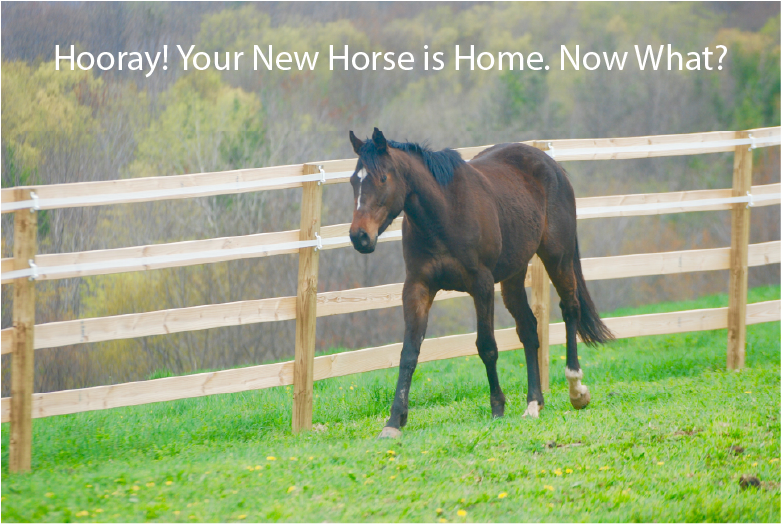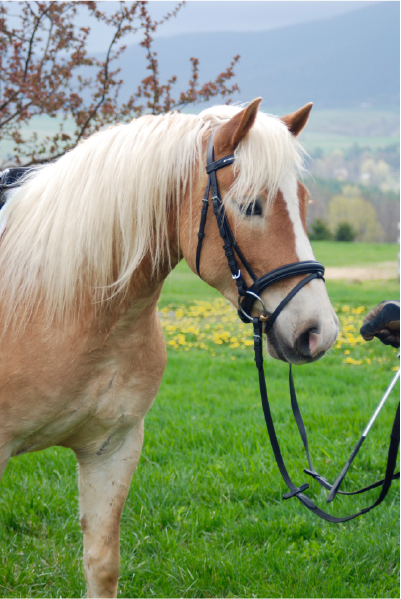Hooray! Your New Horse is Home. Now What?
by Nikki Alvin-Smith

For most of us we toil to find just the right horse for our wants and needs. Finally, we find our next equine partner and can’t wait to have our new critter safely home and in our care.
I do confess I have made a few mistakes in my life when bringing a new horse home. An imported gelding didn’t know what grass was on his arrival from Germany. I did stable him for a night but then turned him out the next morning. He was out of the yard and in the paddock. He was back in the yard. He jumped the gate within minutes to be back in the stable. Unfortunately he wasn’t even a good jumper because he jumped the gate badly. Thankfully no damage to the horse but he took out the gatepost. He was the first agoraphobic horse I have ever owned and right up until his death at 21 years old he never overcame it completely and was sometimes found trotting out and about the property at random. In fact we hand grazed this horse for two hours a day for over a year to try and allow him to overcome his fears. We tried turn out with a pony for company. Different paddocks. No help.
Another time I had bought two ponies for our twins. They had been vetted and looked just fine health wise. I put them in the barn in neighboring stalls and while I did not allow my other horses to visit them nose to nose, I did turn them out in a pasture with a water trough, alternating turnout with another gelding. Both ponies started showing signs of a cold. Yes, my other gelding picked that up too. All were fine thankfully. But it was a silly thing to do.
So here are a few tips to help you make a safe transition with your new horse to your home yard.
Stall First
Have a clean stall, hopefully disinfected and deeply bedded with fresh bedding away from your other horses. For most people meeting U.S.D.A. suggested distances for quarantine just isn’t viable, but any distance will help prevent a contagious disease from spreading. Make sure there is a separate fork and skip for mucking out for this stall as opposed to the rest of the barn, a separate water bucket (and do not touch the water with the end of the hose when filling the bucket), and do not leave Dutch doors open to the outside in the beginning in case your new horse decides to jump out.
You and anyone else mucking out, feeding, handling or touching your new horse should wash their hands thoroughly after each visit.
On arrival you should stable your horse for at least an overnight before turning him out. If he has been on a long trailer ride, a hand graze on grass to keep his digestive tract working is not a bad idea. Do this in an area where you don’t graze other horses. If your horse is too excitable to hand graze safely, then you can always scythe down some grass and take it to him in the stall. Do not use lawn clippings. Do not grain him for the first 24 hours but give him good quality hay. If possible transition him to your hay supply by mixing hay from his prior home. After 24 hours given that your new horse is doing well a small grain ration can be introduced. If possible match the grain manufacturer/type that he was on previously and make any changes to that grain very gradually.
It is a good idea to take your horse’s temperature twice a day for the first several days as a high temperature is often the first sign of any illness. Keep a weather eye on him and leave him alone to rest. Do not overwhelm him with lots of visitors and input.
I try to give any newcomers to our barn 30 days on their own before introducing them to other herd members. If you can give your horse a view of other horses he will also settle more quickly.
Make sure that the horse’s medical record indicates vaccinations and Coggins are up to date. If you don’t have access to that information you should assume he is not up to date and talk with your vet about the appropriate schedule. Bear in mind that vaccinations are often less effective if given during a period of stress.
Turn Out Time
Before you turn out your new horse it is a good idea to worm him. While you can do a fecal worm count this would take time and giving a wormer will prevent contamination of your pasture. It will be good for your horse to be turned out after 12-24 hours if you have a small safe area where he can come to no harm that is away from other horses.
I usually hand walk the horse inside the perimeter of the paddock or field so he can assimilate his environment and show him any electric fencing before turning him loose back at the gate. Leave the halter on just in case he becomes wound up and needs to be brought back to the stable. Stay by the gate and give him time to calm down. Hopefully you have asked his previous owner about his turnout manners and can be confident that your horse will behave and after a few minutes your horse will settle down and graze.
If you don’t have a safe exercise area then you can work the horse on the longe line to exercise him, hand walk and graze him. Spend time with your horse grooming him and give him time to get to know you. In my experience if you start out and assume your horse knows nothing, and work through all your usual routines for grooming, tacking up etc. you will soon find any gaps in his education.
If possible do not share this turnout space with other horses during your quarantine period. Do not share water sources such as the tough either, as these present a high route of disease transmission.
First Ride
If your horse works under saddle then taking him for a short ride will help settle him into his new home. After carefully fitting tack have someone assist you on the ground when you mount for the first time. Do not overwork your horse. A short workout in all three gaits in a safe environment such as a fenced arena is ideal. Expect that your horse may lack focus and be nervous at the start and if he is spooky or overly exuberant longe him or round pen him before riding him.
First Trail Ride
 If your horse is not experienced alone on the trail and as you don’t want to mix him with another herd member yet you can utilize an ATV or similar vehicle to go out with you the first time. Have whoever drives the machine keep a good eye on your horse’s reaction and not go too fast. Most horses will quite happily follow along with an ATV. If you have any doubts about your horse’s experience on the trail start out with just walking around your property or barn and gradually increase the distance from the stables. You can also ride your horse around the pasture that you use for his turnout as he will be familiar with this area. Be certain there are no neighboring pastures full of free horses to add any unneeded excitement.
If your horse is not experienced alone on the trail and as you don’t want to mix him with another herd member yet you can utilize an ATV or similar vehicle to go out with you the first time. Have whoever drives the machine keep a good eye on your horse’s reaction and not go too fast. Most horses will quite happily follow along with an ATV. If you have any doubts about your horse’s experience on the trail start out with just walking around your property or barn and gradually increase the distance from the stables. You can also ride your horse around the pasture that you use for his turnout as he will be familiar with this area. Be certain there are no neighboring pastures full of free horses to add any unneeded excitement.
If your horse has no trail experience it may be wise to wait until you can introduce him to the herd and have a riding buddy you can either pony him from or ride alongside with a friend for his first outing.
Introduction to the Herd
Choose carefully which horse to introduce first to your new equine partner. I usually choose a horse from the middle of my herd, a horse that is neither the leader or dominant horse, and certainly not one from the bottom of the herd. Make the initial introductions with a solid barrier between them such as the grills of the stall. You can stable them next to each other before turn out together as this helps them learn about each other.
It is not fair to just throw your new horse out with the rest of the group. It is far kinder to have him buddy up with one other horse and add another horse one by one over several days. You will need to keep a good eye on the herd dynamics to be sure no- one is bullying or becoming obsessive or possessive over the new horse.
Don’t Be Shy
When you purchased the horse you may have asked the previous owner all sorts of questions but there may still be things you overlooked and would like to know. It is a good idea to simply call the previous owner and ask them. This can save you a lot of wasted time and most sellers will welcome your follow up and be happy to know how your horse is coming along.
In conclusion remember the expression, ‘Make Friends Slowly.’ You and your horse will need time to build trust and establish a positive relationship. Always give your horse the benefit of the doubt. Be consistent, kind and patient and if you run into difficulties seek out a good trainer to help you both transition into the new relationship. While you may have experience with just a few horses, a good trainer will have had positive experiences with a myriad of equines and their knowledge can provide a valuable resource.
Happy Riding!
About the author: Nikki Alvin-Smith is an international Grand Prix dressage trainer/clinician who has competed in Europe at the Grand Prix level earning scores of over 72%. Together with her husband Paul, who is also a Grand Prix rider, they operate a private horse breeding/training farm in Stamford, NY.


